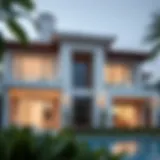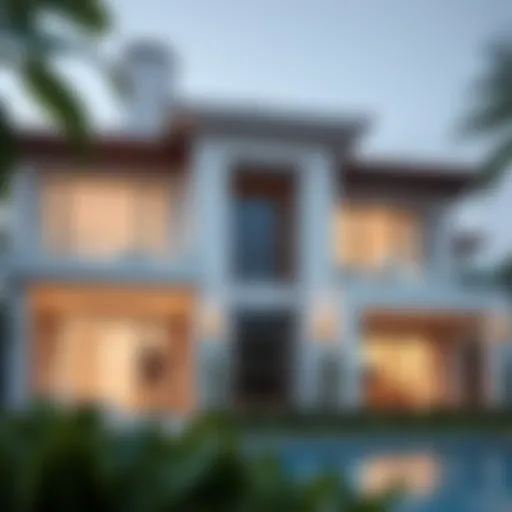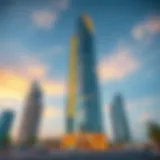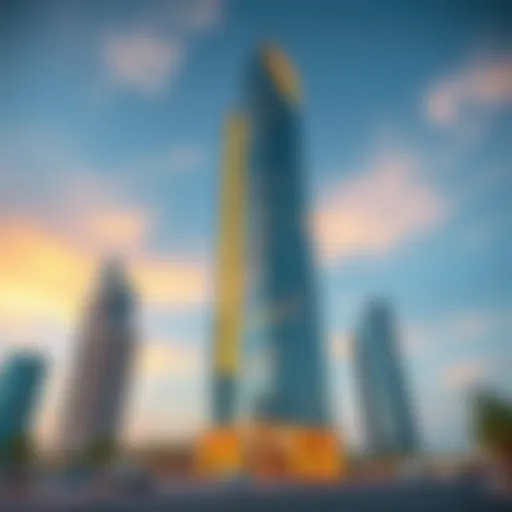Exploring Burj Views and the Central Tower's Impact
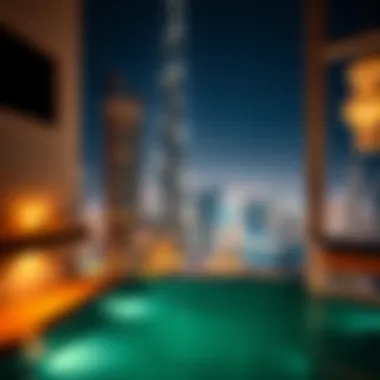

Intro
In the heart of Dubai's skyline, the Central Tower stands as a testament to modern architectural ingenuity. Its interaction with the iconic Burj views extends beyond mere aesthetics; it embodies the dynamic character of a city that constantly reinvents itself. The juxtaposition of these structures creates not only a stunning visual spectacle but also significant economic implications for investors, homeowners, and tourists alike. This analysis aims to unpack the multilayered relationships between the Central Tower, the Burj views, and the broader context within Dubai's ever-evolving real estate market.
Market Trends
Current Real Estate Prices
As of late 2023, the real estate market in Dubai continues to gain traction. Prices around landmarks such as the Burj Khalifa and the Central Tower have surged significantly. Areas within close proximity, particularly those boasting unobstructed views, command premiums.
- Average Price per Square Foot: The Central Tower's prime location contributes to its average selling price per square foot being notably higher than the Dubai market average.
- Luxury Market: Properties with a Burj view are sought after, with luxury developments experiencing price hikes, fueled by foreign investment and a growing expatriate population.
Future Market Predictions
Looking ahead, trends suggest that the real estate market will remain robust.
- Influx of Tourists: The World Expo and other global events are drawing increased visitor numbers, leading to a higher demand for both commercial and residential properties.
- Investment Opportunities: Potential investors eyeing the burgeoning market should consider the sustainability of these trends, factoring in the government's commitment to infrastructure and tourism.
"With the Central Tower serving as a beacon of luxury and modern living, the synergy between architectural finesse and real estate potential is undeniable."
Buying and Renting Guide
Essential Tips for First-Time Buyers
For those considering a purchase in this competitive market, here are some pointers:
- Research Thoroughly: Understand the nuances of property values around major landmarks. The Central Tower's views not only add aesthetic value but significantly impact pricing.
- Legal Framework: Familiarize yourself with the regulations governing foreign ownership in Dubai. Some areas have specific guidelines that could affect your purchasing power.
Navigating Rental Agreements
Renting in Dubai can be as lucrative as buying, especially near prime locations.
- Short-Term vs Long-Term Rentals: Weigh the pros and cons of both. Short-term rentals can offer flexibility and yield quicker returns, while long-term rentals provide stability.
- Key Considerations: Ensure to review the rental agreement meticulously. Pay attention to maintenance responsibilities and any clauses related to renewing the lease.
The Architectural Significance of the Central Tower
The Central Tower stands as a beacon of modern architecture, playing a critical role in the aesthetic and functional narrative of the surrounding Dubai skyline. Within the realm of urban landscapes, its design and purpose intertwine to foster a sense of identity and innovation. This section delves into the distinct characteristics that underscore the architectural significance of the Central Tower, illustrating how they connect to wider themes of modern living and the future of urban development.
Design Innovations
The design of the Central Tower showcases a variety of innovative approaches that reflect contemporary architectural trends. Its silhouette doesn’t just scrape the sky; it tells a story of ingenuity. The structure boasts a unique twisting form, which maximizes views of the iconic Burj while minimizing wind load on the building itself. This integration of form and function is a prime example of how modern architecture pushes boundaries beyond aesthetics.
Furthermore, the implementation of smart technology has revolutionized how the tower operates. For instance, the installation of digital glass allows for dynamic reactivity to the environment; it can adjust opacity based on sunlight, providing comfort to the occupants while also conserving energy. These innovations not only enhance the user experience but also set new standards for sustainable architecture in urban settings. By incorporating advanced design features, the Central Tower exemplifies what can be achieved when creativity is combined with modern science.
Materials and Sustainability
Sustainability is more than a buzzword in modern construction—it is a guiding principle that steers the Central Tower's material choices and overall design philosophy. The architects chose locally sourced materials to reduce carbon footprints, emphasizing the importance of environmental consciousness in urban planning. This approach not only supports the local economy but also diminishes transportation emissions associated with imported goods.
Moreover, the structure’s envelope incorporates high-performance insulation and reflective materials that work hand-in-hand to improve energy efficiency. This thoughtful integration minimizes energy consumption and enhances occupant comfort, presenting a paradigm shift in how skyscrapers can operate sustainably.
In addition, the Central Tower has been designed to promote natural ventilation, utilizing its height and shape to facilitate air flow. This not only lowers the reliance on mechanical climate control systems but also creates an indoor environment that feels connected to the outdoor elements.
"The future of urban growth must harmonize design innovation with sustainability to create spaces that are not just lived in but thrive in."
By viewing the Central Tower through the lens of materials and sustainability, it becomes evident that this iconic structure is more than just a point on a map; it is a testament to the potential for architecture to contribute positively to both community and environment. Understanding these elements allows investors, designers, and future residents to appreciate the true value inherent in such designs, offering insights that resonate well beyond the skyline.
The Burj: A Cultural Icon
The Burj Khalifa, standing tall among Dubai's skyline, epitomizes a cultural and architectural revolution. This towering behemoth is not merely a structure; it embodies the relentless pursuit of innovation and the aspiration for progress, resonating with people not just in the UAE, but across the globe. Understanding the depth of its impact involves delving into its rich historical context and the symbolism encapsulated within its architecture, making it a centerpiece of Dubai's identity and a nexus for investors and visitors alike.
Historical Context
The tale of Burj Khalifa is as grand as its height. Launched in 2004 and officially opened in 2010, this high-rise marvel has roots deeply embedded in the architectural aspirations of Dubai. The structure's inception marked a significant period of economic growth and ambition in the Middle East. Following the oil boom, Dubai aimed to diversify its economy, positioning itself as a global city known for tourism and business endeavors.
Over the years, the Burj has transitioned from a mere construction project to a dynamic symbol of vision and creativity. According to historical accounts and analyses, it represents Dubai's readiness to embrace modernity while honoring its rich cultural roots. Noteworthy is the fact that the Burj was initially named "Burj Dubai," serving as a beacon of the city's skyward ambitions. It wasn’t until the unveiling ceremony that the name was changed to honor Sheikh Khalifa bin Zayed Al Nahyan, the President of the UAE, who supported the project financially during challenging times.
The Burj Khalifa’s development involved a meticulous blend of local and international expertise. Employing design principles that harmonize with Middle Eastern culture, it serves both as a landmark and a source of pride for residents and expatriates.
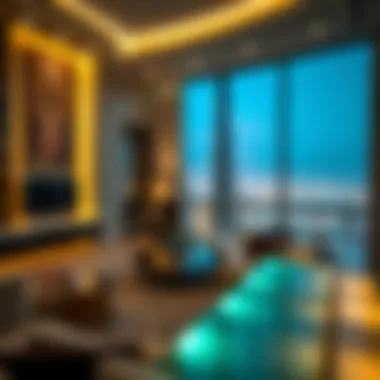

In a nutshell, the Burj Khalifa’s history intertwines with Dubai's narrative, showcasing how a singular structure can emerge as a catalyst for change and a hallmark of national identity.
Symbolism in Architecture
The architecture of the Burj Khalifa is more than just stunning visuals; it is steeped in profound meaning and symbolism. Drawing inspiration from Islamic architecture, the design incorporates elements that evoke the region's cultural and historical significance. Each aspect of the Burj’s design was thoughtfully crated to convey messages of tolerance, identity, and resilience.
For instance, the structure's Y-shaped footprint mimics the desert flower, symbolizing growth in a harsh environment. This organic shape not only facilitates optimal views but also enhances its stability amidst high winds, showcasing a blend of art and science that harkens back to traditional architectural values.
Moreover, the Burj serves as a metaphor for aspiration, representing the idea that dreams are not unattainable but can be actualized with vision and determination. It challenges the very definition of what architecture can be, breaking records and raising the bar for urban development worldwide.
"The Burj Khalifa stands as a reminder that the future can be shaped by our collective ambitions and cultural narratives."
Investors and stakeholders see the Burj as more than a financial opportunity; it symbolizes the possibility of shaping a better urban experience. Its presence has paved the way for other architectural endeavors, suggesting that structures can foster community, identity, and cultural dialogue, which are essential for a growing metropolis like Dubai.
In summary, the Burj Khalifa transcends its role as an architectural feat; it is a cultural touchstone that captures the essence of a society reaching for the stars.
Panoramic Views: A Unique Selling Point
The significance of panoramic views in relation to the Central Tower cannot be overstated. These breathtaking visual expanses serve not only as a feast for the eyes but also as a key factor in attracting investors, residents, and businesses. In a city like Dubai, where the skyline is a canvas of architectural marvels, having a vantage point that offers sweeping views of landmarks such as the Burj Khalifa and the Arabian Gulf can be a game changer for property value and lifestyle appeal.
Residential Appeal
When it comes to residential properties, panoramic views add a layer of allure that transcends mere aesthetics. The vistas capture the spirit of urban living, making every sunrise and sunset an event worth savoring. Here are a few critical points regarding the residential appeal that such views contribute to:
- Enhanced Quality of Life: Imagine waking up to a stunning sunrise over the horizon or enjoying a tranquil evening gazing at the lights of the city as they twinkle against the dark sky. This daily visual experience can greatly enhance one’s overall quality of life.
- Increased Property Value: Properties that boast views of iconic landmarks tend to appreciate faster and hold their value better during downturns in the market. A unit with a clear view of the Burj Khalifa, for instance, can demand a premium over comparable units without the view.
- Psychological Benefits: Studies suggest that having access to nature or expansive views can positively impact mental health. For residents, these views create a calming environment that promotes well-being.
A well-designed residential unit within the Central Tower leverages these panoramic views, making them not just an add-on, but rather a core component of its appeal.
Commercial Opportunities
The commercial realm, too, benefits significantly from the allure of panoramic views. Businesses are keenly aware that location can make or break their success. Thus, proximity to visually striking landmarks offers opportunities that extend beyond basic foot traffic. Consider the following aspects:
- Brand Visibility: A business situated in a high-rise building with sweeping views not only attracts customers but also elevates its brand image. A café or restaurant with views of the Burj, for example, can market itself as a destination rather than just another eatery.
- Event Spaces: Venues that offer stunning views become prime locations for events such as weddings, conferences, or corporate gatherings. Companies are often willing to pay a premium for a memorable backdrop, thus boosting revenue for any business that can provide such a setting.
- Economic Synergy: When businesses co-locate in an area known for its stunning vistas, they create a buzz that draws in more visitors. This aggregation of businesses can lead to economic growth, benefiting all involved as visitors flock to experience the scenery alongside the offerings.
Visitor Experiences at the Central Tower
The allure of the Central Tower extends beyond its architectural grandeur; it is a hub for unforgettable visitor experiences. Here, visitors don’t just look at a building; they engage with the essence of Dubai's modern marvel. Understanding the unique experiences offered at the Central Tower not only shines a spotlight on its tourist appeal but also underscores its importance in elevating the economic landscape of the region.
One key aspect of visitor experiences at the Central Tower is the vast array of viewing platforms and amenities. These spaces are meticulously designed to provide unobstructed views of the iconic Burj Khalifa and the evolving skyline of Dubai. As one ascends the levels of the tower, eyes are greeted by floor-to-ceiling windows that enhance the experience of gazing at the sprawling city below. The observation decks come equipped with interactive displays that offer insights into the city’s history and cultural significance, allowing visitors to connect with the urban environment on a deeper level.
Features such as café lounges and gift shops located on these platforms make the experience all the richer, giving guests a chance to relax and absorb their surroundings. The atmosphere is one of awe and discovery—visitors feel they are standing on the threshold of the extraordinary.
Viewing Platforms and Amenities
The viewing platforms at the Central Tower serve as the crowning jewels of the visitor experience. Constructed with cutting-edge technology, these spaces are designed to accommodate large crowds without feeling overcrowded.
- 360-Degree Views: Each platform offers panoramic views, fourteen floors above the city, allowing guests to soak in the vistas from multiple perspectives.
- State-of-the-Art Elevators: High-speed elevators efficiently whisk visitors to the top, often screen displays in the lift showing real-time information about the journey.
- Observation Deck Design: Benches and comfortable seating areas are available, enabling families and explorers to enjoy leisure time while appreciating the extraordinary landscape.
Moreover, the built-in amenities such as kiosks for refreshments and bathrooms ensure compliance with modern standards, making the visit more pleasant. The combination of practicality and design ensures that visitors have a comprehensive experience.
Guided Tours and Events
Guided tours at the Central Tower add another layer to the visitor experience. Knowledgeable tour guides lead groups on informative excursions, providing detailed context about the architectural techniques used and the inspiration behind the Central Tower’s design. These tours are not merely informational; they foster a sense of connection to the narrative of Dubai’s growth and globalization.
In addition, the Central Tower frequently hosts special events such as cultural showcases and art exhibitions. Visitors can immerse themselves in local traditions while experiencing the convergence of culture and modernity that the tower represents.
Other elements of the guided tours might include:
- Interactive Sessions: Opportunities for visitors to ask questions and interact with experts in architecture and urban planning.
- Exclusive Access: Special rates and packages for access to areas not open to the general public during certain events, enhancing the allure of the experience.
- Community Engagement: Initiatives ensure that locals feel represented and involved, thereby building a sense of community around the tower’s significance.
Overall, the visitor experiences at the Central Tower not only highlight its architectural and historical importance but also play a crucial role in shaping Dubai's identity as a cosmopolitan hub. Engaging and well-designed pathways through this tower not just enchant visitors but also position it as an essential component of Dubai's urban narrative. For more insights about urban development, visit Wikipedia.
"The true power of a city's skyline is not just in its height but in the stories and experiences it offers to those who walk amongst it."
For a closer look at cultural events and programs, check resources like Britannica!
Economic Impact of Iconic Structures
The economic implications of iconic structures, such as the Central Tower with its stunning Burj views, resonate far beyond just the real estate market. These architectural marvels serve as beacons, drawing attention and investment to their locales. The Central Tower is more than just a sophisticated piece of engineering; it plays a critical role in shaping the economic landscape of Dubai. This section explores how such prominent developments can transform a city and highlight their value in real estate, tourism, and local businesses.
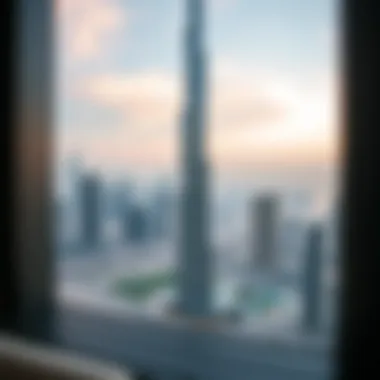

Real Estate Valuation and Investment Trends
The presence of the Central Tower significantly elevates the value of surrounding properties. Investors are naturally drawn to high-demand areas where unique architectural features abound. The tower's allure can boost real estate prices exponentially, creating a ripple effect throughout the market. Buyers and real estate agents must closely observe these trends, as a rise in valuation can signal lucrative opportunities for investment.
- Proximity Premium: Properties located near iconic structures often command higher prices. The views from such developments yield both prestige and a noticeable uptick in desirability, making them attractive for direct investment.
- Gentrification: As more skyscrapers and modern buildings emerge around the Central Tower, neighborhoods undergo transformation. What used to be less desirable locations can become hubs of activity, thus increasing property appeal.
- Speculative Investment: The hype surrounding the tower can lead to speculative buying, where investors purchase properties expecting future appreciation driven by tourism and local interest in the area.
By examining recent sales data and trends, we can see how the Burj views have become essential in reshaping the real estate narrative in Dubai.
Tourism and Local Business Growth
Tourism thrives when there’s something special to see, and the Burj views are indeed captivating. The Central Tower indirectly boosts tourism in ways that benefit local businesses, creating a lively economic environment. Here are the critical aspects of how this iconic structure affects tourism and, in turn, local commerce:
- Increased Foot Traffic: Tourists flock to the Central Tower for its views, leading to increased foot traffic in nearby areas. This directly impacts local shops, cafes, and restaurants as visitors explore the vicinity before or after their visits.
- Cultural Exchange: The presence of international visitors encourages a cultural exchange that businesses can capitalize on. This brings diverse culinary experiences and products to local markets, enhancing the overall appeal of the area.
- Event Opportunities: The Central Tower can host various events that draw crowds, from exhibitions to festivals. These events increase visibility for local businesses and provide a vibrant atmosphere that further attracts tourists.
- Partnerships with Local Enterprises: The increased attraction to the Central Tower opens doors for partnerships between businesses and the establishment itself, allowing for promotional events or unique offerings tailored to visitors.
By fostering a robust tourism sector, the Central Tower not only uplifts local industries but also strengthens Dubai’s position as a global destination.
In summary, the economic impact generated by iconic structures like the Central Tower cannot be overstated. The interconnection between real estate valuation, tourism, and local business growth illustrates how pivotal these architectural wonders are to a city’s economic heartbeat. Investors, agents, and analysts should keep a vigilant eye on these trends, as they signify broader shifts in Dubai's urban landscape.
For more insights into the economic implications of iconic architecture, you may visit resources such as Wikipedia, and articles on platforms like Britannica or discussions in Reddit.
Understanding these factors can provide a comprehensive outlook for anyone interested in the evolving dynamics of Dubai’s skyline.
The Future of Burj Views and Urban Development
The future of Burj views and urban development holds substantial significance within the context of Dubai's skyline transformation. As a city that embraces innovation and growth, the direction taken in developing high-rises not only influences the architectural landscape but also shapes social dynamics, economic opportunities, and environmental considerations in the region. This section delves into critical elements surrounding future development strategies, highlighting benefits, trends, and important considerations that lie ahead for the Burj and the surrounding urban fabric.
Trends in High-Rise Living
High-rise living in urban environments like Dubai is more than just a trend; it reflects changing lifestyles and values. Over the past few decades, the popularity of vertical living solutions has surged, driven by urbanization and the quest for efficiency in land use. Here are some key trends worth noting in this arena:
- Community-Driven Designs: There is a growing emphasis on creating spaces that foster community interaction. This means incorporating shared spaces, such as gardens and lounges, into high-rise designs to encourage social connectivity among residents.
- Wellness Integration: More developments are placing a focus on health and wellness. Integrations like fitness centers, green spaces, and even rooftop gardens offer residents options for relaxation and exercise within proximity to their homes.
- Luxury and Comfort: As consumers become more discerning, high-rise buildings incorporate high-end finishes, smart homes, and amenities like concierge services and private pools, appealing to affluent buyers.
- Adaptability: Future designs are increasingly flexible. Space that can be repurposed for different uses over time caters to changing demographics and market needs, ensuring longevity and relevance in design.
The implications of these trends not only contribute to increased demand for high-rise living but also impact real estate valuations and the local economy.
Smart City Integrations
As urban environments evolve, the concept of smart cities has gained traction. Integrating technology into urban development presents opportunities to enhance efficiency, security, and quality of life for residents. Dubai is at the forefront of this movement, especially when in consideration of plans for the Central Tower and its surroundings. Important aspects of smart city integrations include:
- IoT and Connectivity: The Internet of Things (IoT) can greatly improve living conditions in high-rises. Smart meters, energy management systems, and connected public transportation provide residents with responsive living experiences, optimizing energy usage and transportation efficiency.
- Data-Driven Decision Making: Utilizing big data allows urban planners to analyze patterns in traffic, energy consumption, and even social behavior. This information helps in making informed decisions about future developments and improvements.
- Sustainable Resource Management: Sensor technologies can help manage water usage and energy efficiency across buildings, contributing to Dubai's sustainability targets while minimizing the environmental footprint of high-rises.
- Enhanced Security Systems: The incorporation of advanced surveillance systems and emergency response technologies ensures a safe environment for residents and visitors alike, a priority in urban living spaces.
"Urban development in high-rises represents not just structures but living ecosystems where innovation meets everyday life."
For more insights on architectural developments in Dubai, check resources such as Wikipedia or Britannica.
Challenges in Skyscraper Development
In any discussion about iconic structures such as the Central Tower, understanding the various challenges in skyscraper development becomes crucial. These challenges can dictate not only how a project unfolds but also its overall success and sustainability. Throughout this analysis, it’s essential to note how these complications influence not just the architectural landscape, but also the socio-economic fabric of the region.
Dealing with towering buildings isn’t merely about lifting structures to the sky; it incorporates a convergence of engineering feats and regulatory mandates which can often feel like navigating a labyrinth. By recognizing the multifaceted issue, stakeholders can prepare adequately and innovate solutions.
Regulatory Hurdles
Navigating the regulatory hurdles is one of the first battles when breaking ground for skyscrapers in bustling metropolises like Dubai. These hurdles comprise zoning laws, building codes, and permitting processes which dictate everything from height restrictions to aesthetic controls.
The complexity arises from varying government regulations that are often multilayered, with multiple agencies involved in the approval processes. For example, the Dubai Municipality has specific requirements that one must adhere to that ensure safety and compliance within the mosaic of Dubai's urban environment.
Considerations such as:
- Height Regulations: Local laws may limit how tall a building can be, reflecting the city’s characteristics or preserving views of heritage sites.
- Zoning Rules: These are designed to separate residential, commercial, and industrial spaces, which determines where a skyscraper can be erected.
- Traffic and Infrastructure Planning: Skyscrapers can create congested areas, so developers must consider the surrounding infrastructure to prevent traffic woes.
As a result, each architectural endeavor demands thorough due diligence from the outset. With time being a precious commodity in the real estate world, extensive delays from regulatory challenges can deter investment potential and create setbacks.
"A successful skyscraper is one that doesn’t just touch the skyline but touches the community it serves."
Environmental Concerns
With the rapid advancement of urbanization, the environmental concerns surrounding skyscraper development have gradually risen to prominence. These concerns encompass sustainability practices in construction and the subsequent environmental impact the buildings might have on their surroundings.
Key environmental factors that need to be taken into account include:
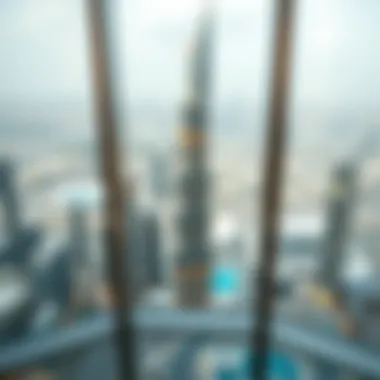

- Energy Efficiency: Skyscrapers consume a substantial amount of energy, and developers must explore integrating renewable energy solutions. Innovations such as solar panels or wind turbines can be game changers.
- Resource Utilization: The materials used in building tall structures can carry significant carbon footprints. Employing recycled materials or locally sourced resources can help reduce this negative impact.
- Water Management: High-rise buildings need effective systems to manage stormwater run-off and irrigation purposes, which poses challenges in arears where water is scarce.
By addressing these environmental issues proactively, developers can not only comply with stringently evolving legislation but also resonate with the increasingly eco-conscious public sentiment. Ignoring these concerns runs the risk of hiking future operational costs and lowering a building’s market appeal.
Comparative Analysis with Other Global Structures
The Comparative Analysis with Other Global Structures serves a pivotal role in understanding how the Central Tower and its Burj views fit into the broader context of architectural excellence and innovation around the globe. It allows us to dissect what makes unique structures stand out and how they influence local landscapes, economies, and cultures. By juxtaposing the Central Tower against other iconic towers and buildings worldwide, we can glean insights that not only inform potential investments but also enrich the dialogue around sustainable design and urban living.
Iconic Towers Worldwide
When examining iconic towers, several examples spring to mind. Take, for instance, the Eiffel Tower in Paris. Initially met with skepticism, today, it epitomizes French culture and draws millions of visitors each year. Similarly, the Shanghai Tower represents the rapid economic ascent of China, towering at a staggering height of 632 meters. Each of these structures reflects local values and aspirations, making them integral to their respective skylines.
Consider also the Petronas Towers in Malaysia, famous not just for their height but for their representation of Islamic architecture and Malaysian identity. The interplay of local culture and design principles lends these towers their global prominence and unique character.
- Height: The Burj Khalifa soars at 828 meters, a fact easily compared to the 605 meters of the Shanghai Tower.
- Design Philosophy: While the Central Tower emphasizes modern minimalism, structures like the Sydney Opera House embrace more organic forms, showcasing the diversity of architectural styles.
- Cultural Significance: Towers such as the Burj Khalifa and Tokyo Skytree serve not just as structures but as symbols of their cities’ ambitions.
Lessons from International Urban Design
The examination of global structures teaches valuable lessons about the intersection of architecture and urban planning. The successful integration of skyscrapers into urban environments depends on various factors: accessibility, public space considerations, and overall urban design.
For instance, Copenhagen's commitment to sustainability has led to the integration of green roofs and public spaces around its towers, promoting not only environmental health but also community engagement. Lessons learned from advancements made in cities like Singapore, with vertical gardens and sustainable design principles, highlight the importance of blending nature within urban landscapes. Sustainability isn't just a trend; it's becoming a necessity.
Factors to consider include:
- Public Spaces: Understanding how to balance private development with community spaces is key to urban success. Towers that neglect this often stand isolated.
- Transportation Access: Structures such as the Willis Tower in Chicago benefit from robust public transport links, enhancing their accessibility and utility.
- Cultural Integration: Successful urban towers resonate with the local culture, as seen in the Burj Al Arab, which reflects traditional Arabic elements through modern design.
"A tower is not merely a vertical structure; it's a narrative of culture, ambition, and sustainability woven into the skyline."
Community Engagement in Urban Projects
Community engagement in urban projects, particularly with towering developments like the Central Tower, is vital for fostering inclusivity and ensuring that the voices of local residents are heard. This aspect of urban planning acts like a bridge, connecting developers with the community, which can greatly influence the success of these projects. A profound understanding of the community allows for designs that truly reflect the needs and desires of those who will interact with the space daily.
Public Spaces and Accessibility
Creating public spaces around the Central Tower enhances accessibility and encourages social interaction. A well-planned area with parks, promenades, and rest zones can serve as a communal hub, inviting families and tourists alike to enjoy the surroundings.
- Design Considerations:
When designing these public spaces, it is essential to consider factors like pedestrian pathways, green areas, and seating options. Easy access to facilities like restrooms, cafes, and convenient transport links fosters a more welcoming environment. - Integration with Local Culture:
Merging cultural elements into these spaces is beneficial. Murals or sculptures that reflect the heritage of Dubai—crafted by local artists—draw a connection between the space and the community's identity. This approach not only beautifies the area but also elevates the sense of belonging for residents. - Environmental Considerations:
Sustainable landscaping can enhance the aesthetic appeal while promoting biodiversity. Green spaces provide natural cooling, important in a climate like Dubai’s, and can mitigate urban heat island effects.
Cultural Events and Programs
Hosting cultural events around the Central Tower is another dimension of community engagement. These programs can transform the area into a vibrant focal point for the city.
- Types of Events: Residents might enjoy markets, art fairs, and music festivals. Each event opens doors for local talent and craftsmanship to shine, creating a platform for cultural exchange.
- Benefits for Local Businesses:
Such programs significantly benefit local businesses as they attract foot traffic and boost sales. A thriving marketplace can further solidify community ties, with small businesses thriving alongside larger developments. - Building Long-Term Relationships:
Community events encourage the public to engage regularly with the tower and surrounding spaces, fostering a relationship between residents and developers.
In summary, community engagement in urban projects is not a mere checkbox; it is a crucial thread in the fabric of successful urban development that prioritizes social inclusion and sustainable growth. These enriched public spaces and vibrant cultural programs stand as testament to urban planning that is truly responsive to community needs and aspirations.
Architectural Trends in Dubai
The architectural landscape of Dubai has undergone remarkable transformations in the past few decades, reshaping not only the skyline but also influencing cultural, economic, and social frameworks. The significance of this topic cannot be overstated, especially in the context of the Central Tower and its Burj views. The unique synthesis of design philosophy and modern technology fuels a constant innovation cycle in construction and planning.
As Dubai continues to position itself as a global city, understanding these architectural trends becomes crucial for investors, buyers, agents, designers, and analysts. These trends hold the key to comprehending market demands, understanding consumer preferences, and recognizing investment opportunities that can lead to lucrative returns.
Integration of Art and Architecture
A hallmark of Dubai's architectural identity is the blending of art with architectural design. This integration is not merely functional but is a statement about the city's cultural aspirations and ambitions. In many instances, buildings in Dubai are adorned with artistic murals, sculptures, and interactive installations that create a dialogue with the surrounding environment.
This trend is particularly evident in developments like the Dubai Opera and the Museum of the Future, where artistry serves as the soul of the architectural form. Not just aesthetically pleasing, these spaces have become cultural hubs, fostering social interaction and community engagement.
- Key Benefits:
- Elevate cultural significance of developments
- Attract tourists and art enthusiasts
- Enhance marketability of properties
The importance of art in architecture also extends to branding—powerful designs become synonymous with their locations, making them instantly recognizable. As a return on investment, structures that incorporate art often see increased foot traffic and visitor engagement.
Sustainability Efforts in Design
Sustainability has taken center stage in architectural trends across Dubai, significantly influenced by global concerns about environmental degradation and climate change. Developers are now recognizing that sustainable practices yield long-term benefits, not only for the planet but also for the occupants and investors. Buildings that embrace sustainability are often seen as more resilient, reducing operational costs over time.
The Central Tower, alongside its illustrious Burj views, serves as a case study in sustainable architecture. Here are some sustainability efforts frequently implemented:
- Use of eco-friendly materials: Incorporating recycled and renewable materials in construction helps reduce waste and lessen the carbon footprint.
- Energy-efficient designs: Features like solar panels, green roofs, and smart energy systems help minimize energy consumption and maintain indoor climate efficiently.
- Water conservation systems: Technologies such as rainwater harvesting and greywater recycling contribute to responsible water usage.
"A sustainable building is not just a structure; it's a statement of values and a commitment to future generations."
The shift towards sustainability is not just a trend but a necessity that increasingly dictates market performance. Properties that can showcase their sustainable credentials tend to see an uptick in interest from environmentally conscious investors and tenants, achieving not just profitability but also societal goodwill.








